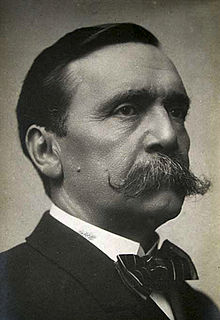Carlos Pellegrini
This article needs additional citations for verification. (December 2009) |
Carlos Pellegrini | |
|---|---|
 | |
| President of Argentina | |
| In office August 7, 1890 – October 11, 1892 | |
| Preceded by | Miguel Juárez Celman |
| Succeeded by | Luis Sáenz Peña |
| Vice President of Argentina | |
| In office October 11, 1886 – August 6, 1890 | |
| President | Miguel Juárez Celman |
| Preceded by | Francisco Bernabé Madero |
| Succeeded by | Jose Evaristo Uriburu |
| Personal details | |
| Born | October 11, 1846 Buenos Aires |
| Died | July 17, 1906 (aged 59) Buenos Aires |
| Nationality | Argentine |
| Political party | National Autonomist Party |
| Spouse(s) | Carolina Lagos |
| Relations | Charles Henri Pellegrini (father) María Bevans Bright (mother) |
| Profession | Lawyer |
Carlos Enrique José Pellegrini (October 11, 1846 – July 17, 1906) was Vice President of Argentina and became President of Argentina from 6 August 1890 to 12 October 1892, upon Miguel Ángel Juárez Celman's resignation (see Revolución del Parque).
The combination of statesman, plus a determined personality in the military field, together with a visionary conception in the field of economics, insertion in the world and political and social reform, make Carlos Pellegrini one of the most complete figures in the world called "Generation of 80".[1]
President of Argentina[]

During his administration, he cleaned up the finances and created the Banco de la Nación Argentina, Argentina's national bank, and the prestigious high-school that carries his name, Escuela Superior de Comercio Carlos Pellegrini, public school of noted academic level, part of Universidad de Buenos Aires.[2]
After the end of his term, he served as senator between 1895 and 1903, and in 1906, he was elected National Representative in the lower house.
His life[]
Pellegrini was son of Swiss-Italian engineer Charles Henri Pellegrini (born in Chambéry) and María Bevans Bright, and grandson of English engineer James Bevans.[3]
Like many other nineteenth century Argentines prominent in public life, he was a freemason.[4]
He died in his native city of Buenos Aires and is buried in La Recoleta Cemetery.
Legacy[]
Being a pioneer in the industry is another of the facets that particularized the thought and action of Carlos Pellegrini, who a century ago perceived the need to accompany agricultural development with industrial development, according to Rosendo Fraga, an Argentine political analyst.[5]
References[]
- ^ http://www.nuevamayoria.com/ES/INVESTIGACIONES/historia/060717.html
- ^ "Archived copy". Archived from the original on 2010-05-29. Retrieved 2010-06-07.CS1 maint: archived copy as title (link)
- ^ Carlos Pellegrini: homenaje al prócer y al Banco de la nación argentina, Cristóbal Osvaldo Zavala, 1941
- ^ The list includes Juan Bautista Alberdi, Manuel Alberti, Carlos María de Alvear, Miguel de Azcuénaga, Antonio González de Balcarce, Manuel Belgrano, Antonio Beruti, Juan José Castelli, Domingo French, Gregorio Aráoz de Lamadrid, Francisco Narciso de Laprida , Juan Larrea, Juan Lavalle, Vicente López y Planes, Bartolomé Mitre, Mariano Moreno, Juan José Paso, Carlos Pellegrini, Gervasio Antonio de Posadas, Domingo Faustino Sarmiento, and Justo José de Urquiza. José de San Martín is known to have been a member of the Lautaro Lodge; but whether the lodge was truly masonic has been debated: Denslow, William R. (1957). 10,000 Famous Freemasons. 1–4. Richmond, VA: Macoy Publishing & Masonic Supply Co Inc.
- ^ http://www.nuevamayoria.com/ES/INVESTIGACIONES/historia/060717.html
External links[]
- 1846 births
- 1906 deaths
- People from Buenos Aires
- National Autonomist Party politicians
- Vice presidents of Argentina
- Presidents of Argentina
- Argentine Freemasons
- Argentine lawyers
- Argentine people of Swiss-Italian descent
- Argentine people of English descent
- University of Buenos Aires alumni
- Burials at La Recoleta Cemetery
- Argentine history stubs
- Argentine politician stubs